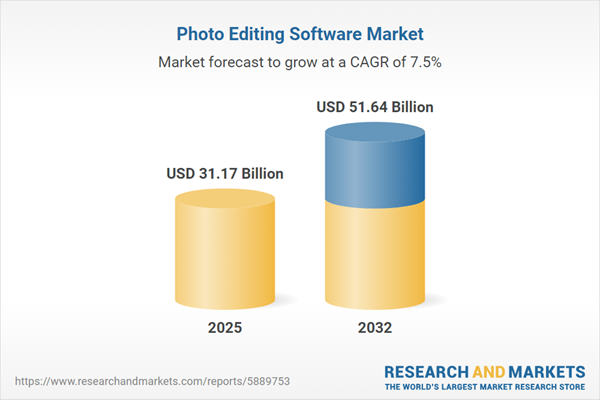Speak directly to the analyst to clarify any post sales queries you may have.
The Photo Editing Software Market is rapidly evolving, driven by technological advancements and surging global demand for high-quality digital content. This report delivers clear, actionable intelligence for senior decision-makers evaluating strategic and operational investments.
Market Snapshot: Photo Editing Software Market Growth and Trends
In 2024, the photo editing software market was valued at USD 29.00 billion, with projections indicating a rise to USD 31.17 billion in 2025. Sustained growth is expected, achieving a CAGR of 7.48% and a forecasted market size of USD 51.64 billion by 2032. This trajectory reflects the market's alignment with the increasing integration of creative tools into professional, educational, and consumer environments worldwide.
Scope & Segmentation: Coverage Across Software, Deployment, Use Case, and Region
- Software Types: Desktop editors, mobile solutions (Android, iOS), and online browser-based platforms are covered, recognizing the need for flexible, device-agnostic workflows.
- Deployment Models: Cloud applications—encompassing hybrid, private, and public infrastructures—alongside on-premise installations, are analyzed to address varying security and operational priorities.
- End Users: The market report covers consumers, the education sector, enterprise users (large and smaller organizations), and government agencies for a comprehensive user base perspective.
- Key Applications: Batch processing, general consumer photo editing, professional editing for graphic design and photography studios, and social media optimization are included.
- Pricing Models: Perpetual licenses (including maintenance and standard options), annual and monthly subscription offerings are evaluated for their impact on user adoption and vendor strategy.
- Distribution Channels: Direct sales (enterprise and website), online stores (app stores, vendor sites), and traditional retail outlets form the basis of coverage.
- Geographic Regions: Analysis spans the Americas (North and Latin America), Europe, Middle East & Africa, and Asia-Pacific, with focus countries highlighted to reflect both mature and emerging markets.
- Technology Integration: The report assesses the influence of artificial intelligence, machine learning, cloud computing, and cross-platform collaboration within the industry.
Key Takeaways for Senior Decision-Makers
- Artificial intelligence features are reshaping editing workflows, supporting automated enhancements and reducing manual effort for both professionals and casual users.
- Shift to subscription-focused models supports continuous feature delivery and faster market response, providing users with regular updates and expanded capabilities.
- Seamless cross-platform integration boosts productivity, allowing editing across desktop, mobile, and browser-based solutions without workflow interruption.
- Regulatory requirements and trade changes, particularly in North American and European markets, necessitate adaptive deployment strategies and localized infrastructure.
- Regional market nuances show divergent preferences, from premium enterprise suites in the Americas and EMEA to mobile-first and cost-sensitive solutions in Asia-Pacific and Latin America.
- Competitive differentiation increasingly relies on innovation partnerships, tailored pricing, and flexible licensing that align with enterprise, education, and public sector needs.
Tariff Impact: Navigating New U.S. Trade Dynamics
Updated United States tariffs implemented in 2025 have influenced hardware sourcing, cloud operations, and pricing strategies for software vendors. These trade adjustments have led many providers to review cost structures, refine distribution logistics, and invest in regional data centers to ensure stable service delivery and margin preservation. Hybrid cloud adoption is growing as organizations balance cloud performance against new cost and compliance factors tied to shifting import regulations.
Methodology & Data Sources
This comprehensive analysis is grounded in primary research with industry executives and IT team leads, supported by extensive secondary review of market reports, financial disclosures, regulatory updates, and peer-reviewed publications. Quantitative and qualitative data have been triangulated from stakeholder interviews, segmented user surveys, and thorough competitive benchmarking.
Why This Report Matters
- Provides clarity on technology and pricing models to support strategic software and infrastructure investments.
- Delivers regional and segmentation insights, enabling leaders to align product offerings with evolving market needs and regulatory expectations.
- Supports data-driven decision-making regarding innovation adoption, market entry, and risk mitigation across global and local contexts.
Conclusion
The photo editing software market is transforming, shaped by shifting technology, user needs, and trade conditions. This report empowers industry leaders to develop informed, future-ready strategies for lasting competitive advantage.
Additional Product Information:
- Purchase of this report includes 1 year online access with quarterly updates.
- This report can be updated on request. Please contact our Customer Experience team using the Ask a Question widget on our website.
Table of Contents
3. Executive Summary
4. Market Overview
7. Cumulative Impact of Artificial Intelligence 2025
Companies Mentioned
The companies profiled in this Photo Editing Software market report include:- Adobe Inc.
- Corel Corporation
- CyberLink Corp.
- Skylum Software Ltd.
- Serif (Europe) Ltd
- DxO Labs SAS
- ACD Systems International Inc.
- ON1, Inc.
- Phase One A/S
- 123RF Pte Ltd
Table Information
| Report Attribute | Details |
|---|---|
| No. of Pages | 183 |
| Published | November 2025 |
| Forecast Period | 2025 - 2032 |
| Estimated Market Value ( USD | $ 31.17 Billion |
| Forecasted Market Value ( USD | $ 51.64 Billion |
| Compound Annual Growth Rate | 7.4% |
| Regions Covered | Global |
| No. of Companies Mentioned | 11 |









